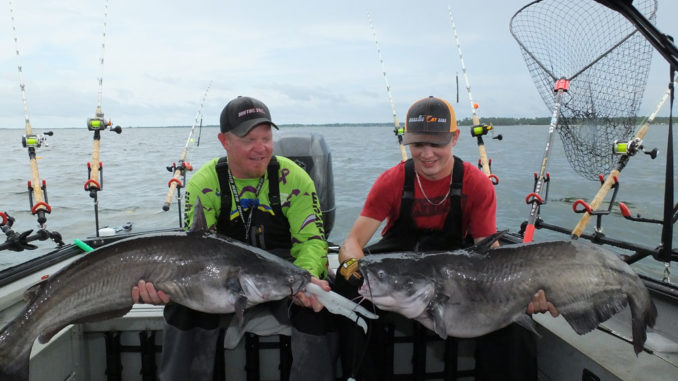
October kicks off the best fishing of the year for trophy blue catfish on the Santee Cooper lakes. It’s prime time to take advantage of these bruisers.
Anglers from throughout the Carolinas make an annual trek to the Santee Cooper lakes in search of trophy catfish, and these enormous cats make it worth the trouble with explosive bites and drag-screaming surges. These pole-bending monsters and are caught throughout the year, but October through December is prime time for hooking these fat and feisty whiskered fish from Lake Moultrie and Lake Marion.
And experts say the excellent fishing has actually been on an upsurge recently.
Bob Winters of Cross, S.C., has guided for catfish and striped bass on the Santee Cooper lakes for nearly 40 years and has watched them morph into a world-class fishery for blue and flathead catfish. Like other anglers Winters suffered when the fishery declined for several years, likely from over exploitation.
“But that’s in the rearview now, because the big cats are back and are here in terrific numbers,” Winters said. “We had a few years when big catfish became scarce, but in recent years, the trend has completely reversed. Now, 40-pound catfish are a reasonable goal, and 20- to 35-pound fish are very frequently caught. We can’t guarantee big fish every day, but the fishing is so good now that I’m disappointed if we don’t catch them.”
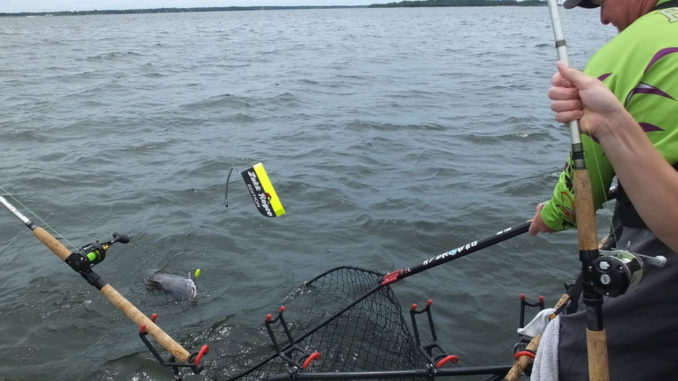
Winters said catching trophy catfish begins with having them available in good numbers and using the right techniques at the right time of the year.
Kevin Davis, owner of Blacks Camp, has also monitored the comeback of big catfish for many years. He said big cats are caught throughout the year, with spring and fall best for sustained success on trophy fish, but big cats are taken year round.
“Right now, I’d say a 40-pound catfish is the trophy standard for most, but make no mistake, we see numerous 50- to 70-pound catfish, and fish over 80 pounds are occasionally weighed,” Davis said. “A new state record was caught on rod and reel in Lake Moultrie last year, weighing 113 pounds. The trophy catfish fishery is great and I think is on the upswing right now.”
Davis said the key to catching big catfish is pinpointing a specific target that is a bit different from the surrounding underwater topography.
“Big catfish, like big bass and other species, have learned to gravitate to these areas,” he said. “Another important aspect is patience. Trophy catfish often require patience, the same patience a deer hunter needs when sitting in a stand for hours waiting on a big buck. I’ll fish a specific spot hard if I think the odds are good for a big catfish. Moving around can occasionally help a person find scattered, smaller fish, but trophy catfish usually require an investment of time.”
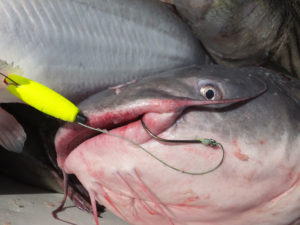
Tournament fishermen have learned how to target big catfish, because most major tournaments limit the number of fish to be weighed.
Benji Brown, a seasoned tournament fisherman from Spartanburg, S.C., said Santee Cooper is a great trophy fish destination and one he enjoys fishing year-round.
“In most catfish tournaments, we can only weigh three or five fish, depending on the specific event,” he said. “Tournament fishing has taught me to focus my efforts on tactics likely to generate bites from really big catfish, not strictly numbers of fish. At Santee Cooper, these tactics include finding forage, working specific locations and using the right technique for each specific target.”
Brown’s tournament partner is his 17-year-old son, Riley, who said specific, big-fish targets change throughout the year while the generic pattern remains the same. He said he and his father focus on ditches, ledges and humps and will use lake maps to identify potential areas and confirm specific locations with electronics.
“Ditches are highways for big catfish at Santee Cooper,” Benji Brown said. “I focus on areas that have different depths of water in the same vicinity, and while big catfish may be caught in deep or shallow water, they are usually close to changing water depths. Big catfish move to and from different depths along specific, identifiable routes. Find these routes, and you’ve got a good start.”
Brown said the next phase is to use electronics, not only to find these areas but to find forage and often big fish marked on or near the bottom in these areas. When he locates a potential target with both forage and big fish on his graph, he determines the best fishing technique to use.
“I like to drift-fish with a Santee rig as my go-to technique, and that often works great at Marion or Moultrie because we’ll often find fish scattered all over a specific hump or ledge with scattered clouds of batfish present,” he said. “Drift-fishing enables me to cover a larger area effectively in that situation. When I find a place that’s loaded with catfish in a very specific area, then an anchor setup may work best. I’ll use flat-line rigs around the boat to target that catfish-rich environment. The only hard and fast rule here is that no single rule exists. I employ the technique that gives me access to more big fish.”
Brown said trophy catfish have a strong affinity for fresh bait; he changes baits on every rod at least hourly. He said Santee Cooper is also unique, based the lakes he’s fished, because he frequently catches huge catfish on small baits.
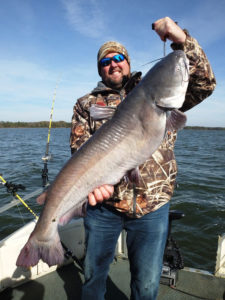
“I’m not sure the specific reason, but it’s not an occasional occurrence, it’s a pattern here,” he said. “Big baits produce great here as well, so I use both.”
Brown said that at Santee Cooper, fishermen must go one step further on bait selection when targeting trophy catfish.
“Gizzard shad, threadfin shad and white perch are certainly prime natural baits, but these lakes have an influx of several different forage species big catfish will eat,” he said. “The best bait at a given time is a moving target because the forage situation changes.
Brown said during the course of the year, shad, river herring, menhaden and mullet all enter the system via the St. Stephens Fish Lift and the locks at the Pinopolis Dam on the Cooper River.
“When these seasonal forage flood into the lakes, they typically become the main chow for big catfish,” Brown said. “Big cats are at the top of the food chain and will eat what they want and what’s most readily available.
“If you don’t use the right bait at the right time of the year you’ll slash the odds of trophy fish success. Traditional baits will still produce, but often are not as effective as the seasonal smorgasbord available.”
Brown’s final recommendation for trophy cats at Santee Cooper is to use planer boards for catfish. He said using planer boards definitely produce most of his big fish bites.
“I think getting the bait away from the boat makes a difference,” he said. “Perhaps the passing of the boat overhead and the pinging of the sonar impacts fish. We certainly catch large catfish on rods being drifted directly behind the boat, but I’ve done the math, and we catch way more big fish using planer boards.”
Davis said a shallow-water connection for big catfish is overlooked by many for big fish.
“This past summer, when the water temperature was high and weather hot, a lot of big catfish were caught in shallow water,” he said. “I’m not saying to fish skinny water exclusively, but I think it’s vastly underrated in terms of producing big catfish here. Our lakes have a tremendous amount of shallow water, and this shallow water often holds forage that big cats prefer during all seasons, not just during the spring as many think.”
Brown said he and son often catch big catfish in skinny water during the extremes of winter and summer.
“We have places where we consistently catch huge catfish in less than 7 feet of water during January and February,” he said. “Also, when fishing at night during mid-summer and fall, one common setup we prefer is to fish in 2 feet of water that’s close to deeper water.”

Davis said the big catfish factory is back in high production thanks in part to the regulations protecting the resource, as well anglers releasing big catfish.
“I am a firm believer that guides and many fishermen now performing CPR on catfish are helping the resource for the future,” he said. “Specifically, that’s Catch. Photograph and Release trophy (fish) while keep smaller fish for consumption. The numbers of smaller fish are high, so that won’t hurt the resource. These big fish are one key to successful spawns and to the continued prosperity of this amazing trophy catfish-catching opportunity.”
Davis said if anglers are targeting trophy catfish for the first time, they need to ensure they employ quality equipment and terminal tackle.
“With the standing and submerged timber, stumps, logs and other bottom debris, I recommend 7- to 8-foot, heavy action rods, quality reels spooled with line in the 30- to 50-pound class as a minimum,” he said. “Big cats are occasionally caught with lighter tackle, but tackle not suited to taking trophy fish in heavy cover often ends in heartbreak for the angler. Most guides use 7/0 up to 9/0 circle hooks when targeting trophy catfish.”
DESTINATION INFORMATION
HOW TO GET THERE — Lake Marion and Lake Moultrie are just north of I-26 between Charleston and Columbia, with I-95 crossing Lake Marion, providing access to fishing camps on both sides of the lakes. The Diversion Canal connects the two lakes and is a prime area for fishing either lake with numerous fishing camps available for lodging, boat access and tackle supplies. For complete details visit www.santeecoopercountry.org.
WHEN TO GO — Spring and fall are the rime times for trophy catfish action, but October through December typically produces some of the most consistent trophy fish action of the year.
BEST TECHNIQUES — Use fresh live or cut bait on heavy tackle along ditches, humps or ledges in the two lakes. Fish may be very shallow or deep, but water less than 15 feet deep has the potential to produce year-round. Use electronics to find underwater ledges, forage and catfish.
FISHING INFO/GUIDES — Kevin Davis, 843-312-3080; Dave Hilton, 843-870-4734; Bob Winters, 843-700-0626; Santee Cooper Country, 800-227-8510, www.santeecoopercountry.org. See also Guides & Charters in Classifieds.
ACCOMMODATIONS — Blacks Camp, 843-753-2231; Santee Cooper Country, 800-227-8510, www.santeecoopercountry.org.
MAPS — Fishing Hotspots, 800-338-5957; Kingfisher Maps, 800-326-0257, www.kfmaps.com; DeLorme’s South Carolina Atlas & Gazetteer, 207-846-7000, www.delorme.com.

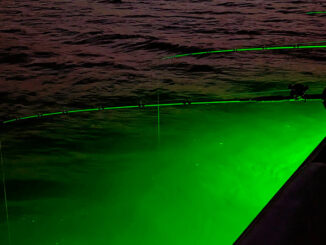
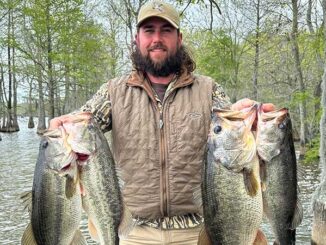


Be the first to comment